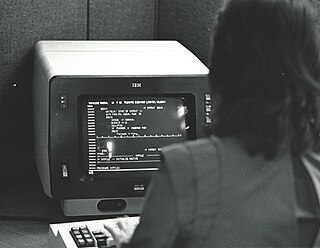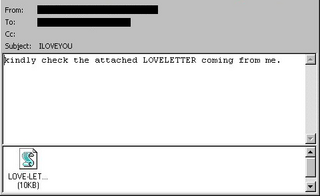
In computer programming, a macro is a rule or pattern that specifies how a certain input should be mapped to a replacement output. Applying a macro to an input is known as macro expansion.

A text editor is a type of computer program that edits plain text. An example of such program is "notepad" software. Text editors are provided with operating systems and software development packages, and can be used to change files such as configuration files, documentation files and programming language source code.
A filename extension, file name extension or file extension is a suffix to the name of a computer file. The extension indicates a characteristic of the file contents or its intended use. A filename extension is typically delimited from the rest of the filename with a full stop (period), but in some systems it is separated with spaces.

The Conversational Monitor System is a simple interactive single-user operating system. CMS was originally developed as part of IBM's CP/CMS operating system, which went into production use in 1967. CMS is part of IBM's VM family, which runs on IBM mainframe computers. VM was first announced in 1972, and is still in use today as z/VM.

This timeline of computer viruses and worms presents a chronological timeline of noteworthy computer viruses, computer worms, Trojan horses, similar malware, related research and events.

MUSIC/SP was developed at McGill University in the 1970s from an early IBM time-sharing system called RAX.

VM is a family of IBM virtual machine operating systems used on IBM mainframes System/370, System/390, zSeries, System z and compatible systems, including the Hercules emulator for personal computers.
VNET is an international computer networking system deployed in the mid-1970s and still in current, but highly diminished use. It was developed inside IBM and provided the main email and file-transfer backbone for the company throughout the 1980s and 1990s. Through it, a number of protocols were developed to deliver email amongst time sharing computers over alternative transmission systems.

CMS Pipelines is a feature of the VM/CMS operating system that allows the user to create and use a pipeline. The programs in a pipeline operate on a sequential stream of records. A program writes records that are read by the next program in the pipeline. Any program can be combined with any other because reading and writing is done through a device independent interface.

XEDIT is a visual editor for VM/CMS using block mode IBM 3270 terminals.

ILOVEYOU, sometimes referred to as the Love Bug or Loveletter, was a computer worm that infected over ten million Windows personal computers on and after 5 May 2000. It started spreading as an email message with the subject line "ILOVEYOU" and the attachment "LOVE-LETTER-FOR-YOU.TXT.vbs". At the time, Windows computers often hid the latter file extension by default because it is an extension for a file type that Windows knows, leading unwitting users to think it was a normal text file. Opening the attachment activates the Visual Basic script. First, the worm inflicts damage on the local machine, overwriting random files, then, it copies itself to all addresses in the Windows Address Book used by Microsoft Outlook, allowing it to spread much faster than any other previous email worm.

VPS/VM was an operating system that ran on IBM System/370 – IBM 3090 computers at Boston University in general use from 1977 to around 1990, and in limited use until at least 1993. During the 1980s, VPS/VM was the main operating system of Boston University and often ran up to 250 users at a time when rival VM/CMS computing systems could only run 120 or so users.
CMS EXEC, or EXEC, is an interpreted, command procedure control, computer scripting language used by the CMS EXEC Processor supplied with the IBM Virtual Machine/Conversational Monitor System (VM/CMS) operating system.
EXEC 2 is an interpreted, command procedure control, computer scripting language used by the EXEC 2 Processor originally supplied with the CMS component of the IBM Virtual Machine/System Product (VM/SP) operating system.
BITNET was a co-operative U.S. university computer network founded in 1981 by Ira Fuchs at the City University of New York (CUNY) and Greydon Freeman at Yale University. The first network link was between CUNY and Yale.

A computer virus is a type of malware that, when executed, replicates itself by modifying other computer programs and inserting its own code into those programs. If this replication succeeds, the affected areas are then said to be "infected" with a computer virus, a metaphor derived from biological viruses.

In computing, a script is a relatively short and simple set of instructions that typically automate an otherwise manual process. The act of writing a script is called scripting. A scripting language or script language is a programming language that is used for scripting.

Rexx is a programming language that can be interpreted or compiled. It was developed at IBM by Mike Cowlishaw. It is a structured, high-level programming language designed for ease of learning and reading. Proprietary and open source Rexx interpreters exist for a wide range of computing platforms; compilers exist for IBM mainframe computers.
TRICKLE was a file-forwarding service on the BITNET (EARN/NetNorth/GulfNet) network.
Remote Spooling Communications Subsystem or RSCS is a subsystem of IBM's VM/370 operating system which accepts files transmitted to it from local or remote system and users and transmits them to destination local or remote users and systems. RSCS also transmits commands and messages among users and systems.












